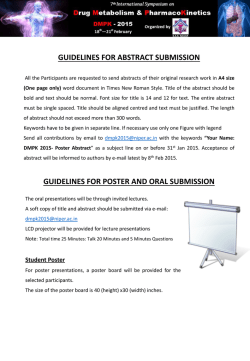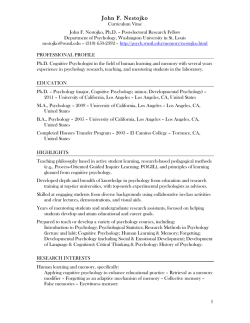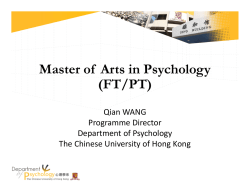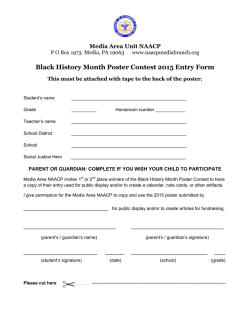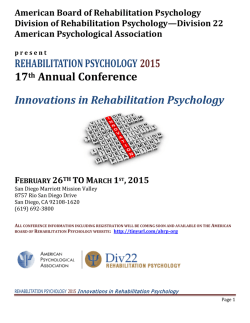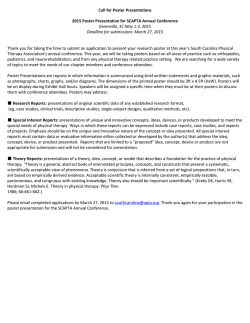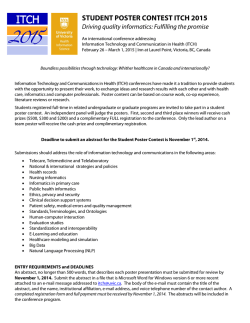
Vita (pdf) - Kansas State University
VITA MICHAEL E. YOUNG January 2015 PERSONAL DATA Office Address 492 Bluemont Hall Kansas State University Manhattan, KS 66506 (785) 532-0602 Internet [email protected] www.k-state.edu/psych/research/youngmike.html EDUCATION 1995 Ph.D. University of Minnesota, Minneapolis Major: Psychology (Cognitive) Minor: Cognitive Science Thesis Title: A Computational analysis of causal induction: The Humean cues to causality. Advisors: Randy Fletcher, Bruce Overmier 1991 MS University of Minnesota, Minneapolis Major: Computer Science (Artificial Intelligence) Minor: Cognitive Science 1984 BS University of Illinois, Urbana/Champaign Major: Computer Science PROFESSIONAL POSITIONS 2012 – Present Department Head and Professor of Psychological Sciences, Kansas State University. 2008 - 2012 Professor of Psychology, Brain and Cognitive Sciences program, Southern Illinois University at Carbondale. 2004 - 2008 Associate professor of Psychology, Brain and Cognitive Sciences program, Southern Illinois University at Carbondale. M. E. Young, Vita, 2 2000 - 2004 Assistant professor of Psychology, Brain and Cognitive Sciences program, Southern Illinois University at Carbondale. 1995 - 2000 Adjunct assistant professor and postdoctoral associate, University of Iowa Psychology Department. Supervisor: Dr. Edward Wasserman 1984 - 1995 Research Consultant for US Army CERL, Champaign, IL. Part-time. 1991 - 1995 Instructor, University of Minnesota Psychology Department. Part-time. 1985 - 1988 Systems Analyst, Procter & Gamble, Cincinnati, OH. Full-time. HONORS AND AWARDS 2005 2000 1999 1997 Elected Fellow of the American Psychological Association, Division 3 Dean’s Appreciation Award, Southern Illinois University College of Liberal Arts APA Division 3 (Experimental Psychology). New Investigator Award - Honorable Mention. Young, M.E., Wasserman, E.A., Hilfers, M.A., & Dalrymple, R.M. (1999). An examination of the pigeon’s variability discrimination using lists of successively presented stimuli. JEP: Animal Behavior Processes, 25, 475-490. APA Division 6 (Behavioral Neuroscience and Comparative Psychology). Best published paper by a recent investigator - Honorable Mention. Young, M.E. & Wasserman, E.A. (1997). Entropy detection by pigeons: Response to mixed visual displays after same-different discrimination training. JEP: Animal Behavior Processes, 23, 157-170. FUNDING HISTORY External 2014 2010 – 2014 2007 – 2010 2007 – 2009 Factors affecting consumer choice of confectionaries. PI of grant funded by the Hershey Company. Total award: $50,000. Waiting for a better future: Deciding when to “cash in” when outcomes are continuously improving. PI of grant funded by the National Institute for Drug Abuse (E.A. Jacobs, Co-Investigator). Total award: $218,250. NIDA 1R15-DA026290 Choosing among causal agents in a dynamic environment. PI of grant funded by the National Science Foundation. Total award: $100,897. NSF SES-0720588 Choosing among causal agents in a stressful environment. PI of grant funded by the Air Force Office for Scientific Research. Total award: $142,899. AFOSR FA9550-07-1-0429 M. E. Young, Vita, 3 1999 – 2003 Internal 2013 – 2014 2012 2007 2002 – 2003 Entropy and same-different conceptualization. Co-PI with Dr. E. Wasserman of grant funded by the National Science Foundation. Total award: $286,056. Marketing of the undergraduate research experience in Psychological Sciences. K-State Academic Excellence Award. Total award: $2,000. Conference travel funds for undergraduate researchers. K-State Academic Excellence Award. Total award: $4,000. Simulated data analysis on the web: Enhancing the understanding of distributional and sampling assumptions. SIUC Excellence Through Commitment Undergraduate Teaching Enhancement Award. Total award: $13,760 Eye movement and the perception of causality. PI of grant funded by the Office of Research Development and Administration, Southern Illinois University at Carbondale. Total award: $15,832. PROFESSIONAL SERVICE Service to Kansas State University 2012 – Present Head, Department of Psychological Sciences 2014 – 2015 University Distinguished Professors Graduate Student Award Selection Committee 2014 – 2015 Chair, Search Committee, national search for Head of Department of Art 2014 Member, Search Committee, internal search for Associate Dean for Academic Affairs and Research, Graduate School 2014 Member, Performance Review Committee, Associate Dean of Research, College of Arts and Sciences 2014 Faculty advisor for Summer Undergraduate Research Opportunity Program (SUROP) student, Cynthya Morales 2014 Presentation, Time-based Incentives in Video Game Tasks, Faculty Exchange for Teaching Excellence Workshop: Actively Engaging the Brain. 2013 – 2014 SUROP workshop presentation, A Presentation on Presenting 2013 Member, Search Committee, Academic Advisor for Psychological Sciences 2013 K-State Research Forum undergraduate poster session judge Service to Southern Illinois University at Carbondale 2011 – 2012 Member of Clinical Psychology search committee, Department of Psychology 2011 – 2012 Member, Promotion (to Full Professor) Review Committee for the Department of Political Sciences 2008 – 2012 Member, Campus-Wide Assessment Committee 2005 – 2012 Member of the Core Council, Center for Integrated Research in Cognitive and Neural Sciences Member of Center Director Search Committee, 2007 – 2008. 2010 – 2011 Member of College of Liberal Arts Promotion and Tenure Committee M. E. Young, Vita, 4 2005 – 2011 2010 2007 – 2009 2001 – 2007 2006 – 2007 2006 – 2007 2001 – 2004 Member of Faculty Seed Grant Review Panel, Social Sciences, Office for Research Development and Administration 2005; 2006; 2011 Member of College of Liberal Arts Writing Requirement Assessment Group Member of Graduate Council Member of Graduate Council Program Review Committee, 2007 – 2009. Member of Ad Hoc Committee on Interim Appointments, 2008 – 2009. Member of Academic Calendar Committee, 2007 – 2008. Program Director of Brain and Cognitive Sciences, Department of Psychology Member, Classroom Initiative Committee Member, Masters Fellowship Review Panel Chair of Brain and Cognitive Sciences search committees (3) Department of Psychology Service to Discipline 2015 – Present Editorial Board, Journal of the Experimental Analysis of Behavior 2010 – Present Editorial Board, Frontiers in Comparative Psychology 2005 – Present Consulting Editor, Learning and Behavior 2005 – 2014 External Reviewer for Promotion and/or Tenure University of North Texas (2014) Stony Brook University (2013) Georgia Southern University (2012; 2013) University of Toledo (2005; 2011) University of Texas at El Paso (2007) 2012 Ad hoc Member, National Institutes for Health (NIH), Biobehavioral Regulation, Learning and Ethology (BRLE) Study Section Review Panel 1999 – 2012 Conference Session Chair Annual meeting of the Psychonomic Society (2012), Judgment and Dec Making APA Annual Conference (2009), APA Division 3 Fellows Session Annual meeting of the Psychonomic Society (2007), Event Cognition Annual meeting of the Psychonomic Society (2003), Category Learning Annual meeting of the Psychonomic Society (1999), Categorization I 2009 – 2010 APA Accreditation Visitation Teams, Generalist Member University of Cincinnati, Clinical Psychology (2010) University of Toledo, Clinical Psychology (2010) University of North Carolina at Chapel Hill, School Psychology (2009) 2010 External Reviewer, Auburn University Department of Psychology 2001 – 2010 Member of student poster award committee, Society for Judgment and Decision Making (2001; 2002; 2010) 2007 – 2009 Fellows Committee, APA Division 3 (Experimental Psychology) Assistant Chair for 2007-2008, Chair for 2008-2009. M. E. Young, Vita, 5 1995 – Present Ad hoc Reviewer for: Acta Psychologica American Journal of Psychology Animal Behavior and Cognition Animal Cognition Applied Cognitive Psychology Archives of Scientific Psychology Attention, Perception and Psychophysics Behavior Research Methods Behavioural Processes Biological Psychology Cognition Comparative Cognition and Behavior Reviews Computers in Human Behavior Developmental Psychology Experimental and Clinical Psychopharmacology Experimental Psychology Frontiers in Comparative Psychology Frontiers in Perception Science Genetic, Social, and General Psychology Monographs IEEE Transactions on Autonomous Mental Development International Journal of Comparative Psychology Journal of Behavioral Decision Making Journal of Comparative Psychology Journal of the Experimental Analysis of Behavior Journal of Experimental Education Journal of Experimental Psychology: Animal Behavior Processes Journal of Experimental Psychology: General Journal of Experimental Psychology: Learning, Memory and Cognition Learning and Behavior Learning and Motivation Memory and Cognition Perception and Psychophysics Perceptual and Motor Skills Perspectives on Psychological Science PLOS Computational Biology PLOS ONE Psychonomic Bulletin and Review Psychological Bulletin Psychological Record Psychological Science Psychological Review Quarterly Journal of Experimental Psychology Scandinavian Journal of Psychology Social Cognition Visual Cognition Grant Proposal Reviewer for: National Institutes of Health (BRLE study section, ad hoc member, 2012), National Science Foundation (multiple grants), Austrian Science Fund, Wellcome Trust, Marsden Fund of the Royal Society of New Zealand. Textbook Reviewer for: Allyn and Bacon, Wiley Publishing, Wadsworth Publishing, Sage Publications. OTHER PROFESSIONAL ACTIVITY Council of Graduate Departments of Psychology New Chair Training, 2014 Grant Statistical Consultant, Dr. David Gilbert of Southern Illinois University at Carbondale (2010 – Present) American Council of Education New Chair Training, 2012 M. E. Young, Vita, 6 PROFESSIONAL AFFILIATIONS Fellow, American Psychological Association Fellow, Psychonomic Society Member, Association for Psychological Science Member, Council of Graduate Departments of Psychology Member, Society for Judgment and Decision Making Member, Kansas State University Academy of Fellows Behavioral and Brain Sciences Associate TEACHING INTERESTS Cognitive Psychology Judgment and Decision Making Research Methods Statistical Methods TEACHING EXPERIENCE 2012 – Present Kansas State University Psychological Sciences Department. DAS 199: Predicting the Future: Mind vs. Math. CAT Community course. Psychology 200: Junior Seminar. Psychology 425/825: Judgment and Decision Making. Psychology 958: Mathematical Models of Behavior. 2000 – 2012 Southern Illinois University Psychology Department. Psychology 211: Research Methods and Statistics in Psychology. Psychology 466: Intermediate Statistics. Psychology 471/528: Judgment and Decision Making. Psychology 489: Seminar on Dog Behavior. Psychology 489: Seminar on Predicting the Future - Mind or Mathematics? Psychology 575: Computational Modeling. Psychology 590: Graduate Seminar – Advanced Cognitive Psychology. 1995 – 2000 University of Iowa Psychology Department. Psychology 31:016: Introduction to Cognitive Psychology. Co-taught. Psychology 31:043: Evaluating Psychological Research (a research methods course). Psychology 31:119: Memory and Cognition (advanced cognitive). 1991 – 1995 University of Minnesota Psychology Department. Psychology 1005: Introductory Laboratory Psychology: Animal Learning and Human Memory. Psychology 3011: Introduction to Animal Learning. Psychology 3051: Introduction to Cognitive Psychology. M. E. Young, Vita, 7 Psychology 5015: Advanced Cognitive Psychology. Graduate Degrees Completed under my Supervision Kansas State Lisa Vangsness, M.S. (2016 – Expected) Angela Crumer, Ph.D. (2015 – Expected) Anthony McCoy, M.S. (2015 – Expected) SIUC James Cole, M.A. (2011), Ph.D. (2015 – Expected; Co-chair) Tara Webb, M.A. (2013; Co-chair) Joseph Geeseman, Ph.D. (2012; Co-chair) Naval Air Systems Command, Lieutenant Steven Sutherland, M.A. (2009), Ph.D. (2012) Northeastern U., Postdoc Deborah Racey, M.A. (2007), Ph.D. (2009) Wright-Way Rescue, Animal Welfare Assoc. Nam Nguyen, M.A. (2009) Design Interactive, Research Associate Joshua Carlson, Ph.D. (2008; Co-chair) Northern Michigan U., Asst. Professor Steven Neese, Ph.D. (2007; Co-chair) Baldwin Wallace, Asst. Professor Roberto Limongi, Ph.D. (2007) U. Diego Portales (Chile), Assoc. Professor Joshua Beckmann, M.A. (2005), Ph.D. (2007) University of Kentucky, Asst. Professor Olga Falmier, M.A. (2004), Ph.D. (2007) Independent Consultant Michelle Ellefson, Ph.D. (2002; Co-chair) University of Cambridge (UK), Sr. Lecturer RESEARCH INTERESTS Impulsive decisions. Acquisition and perception of causal and temporal relationships in the environment. Comparative approaches to the study of variability discrimination. Computational models. REFERENCES Available upon request. M. E. Young, Vita, 8 PUBLICATIONS AN “*” DESIGNATES A GRADUATE STUDENT CO-AUTHOR, “**” AN UNDERGRADUATE STUDENT, AND “#” INDICATES POSTDOCTORAL ASSOCIATE (AT THE TIME OF SUBMISSION). JOURNAL ARTICLES 1. Peissig, J.J., Nagasaka, Y., Young, M.E., Wasserman, E.A., & Beiderman, I. (accepted pending minor revision). Using the reassignment procedure to test object representation in pigeons. Learning and Behavior. 2. Sutherland, S.C., Harteveld, C., & Young, M.E. (in press). The role of environmental cues in relying on automation. Proceedings of the SIGCHI Conference on Human Factors in Computing Systems. 3. * 4. * Webb, T.L, & Young, M.E. (in press). Waiting when both certainty and magnitude are increasing: Certainty overshadows magnitude. Journal of Behavioral Decision Making. Rung, J.M., & Young, M.E. (2015). Learning to wait for more likely or just more: Greater tolerance to delays of reward with increasingly longer delays. Journal of the Experimental Analysis of Behavior, 103, 108-124. 5. Young, M.E., & *McCoy, A.M. (2015). A delay discounting task produces longer waiting than an equivalent deferred gratification task. Journal of the Experimental Analysis of Behavior, 103, 180-195. 6. Young, M.E. (2014). Sex differences in the inference and perception of causal relations within a video game. Frontiers in Psychology, 5, 926. doi: 10.3389/fpsyg.2014.00926. 7. Young, M.E., *Webb, T.L., **Rung, J.M. & *McCoy, A.M. (2014). Outcome probability versus magnitude: When waiting benefits one at the cost of the other. PLOS ONE, 9(6), e98996. doi:10.1371/journal.pone.0098996. 8. ** Rung, J.M., & Young, M.E. (2014). Training tolerance to delay using the escalating interest task. Psychological Record, 64, 423-431. doi:10.1007/s40732-014-0045-8. 9. Young, M.E., & Racey, D.E. (2014). Effects of response frequency constraints on learning in a non-stationary multi-armed bandit task. Special Issue of the International Journal of Comparative Psychology, 27, 106-122. 10. Lazareva, O., Young, M.E., & Wasserman, E.A. (2014). A three-component model of relational responding in a transposition task. Journal of Experimental Psychology: Animal Learning and Cognition, 40, 63-80. M. E. Young, Vita, 9 11. Young, M.E., *Webb, T.L., **Rung, J., & Jacobs, E.A. (2013). Sensitivity to changing contingencies in an impulsivity task. Journal of the Experimental Analysis of Behavior, 99, 335-345. 12. Limongi, R., *Sutherland, S.C., *Zhu, J., Young, M.E., & Habib, R. (2013). Temporal prediction errors modulate cingulate-insular coupling. NeuroImage, 71, 147-157. 13. Young, M.E., *Webb, T.L., *Sutherland, S.C., & Jacobs, E.A. (2013). Magnitude effects for experienced rewards at short delays in the escalating interest task. Psychonomic Bulletin and Review, 20, 302-309. 14. Castro, L., Wasserman, E.A, & Young, M.E. (2012). Variations on variability: Effects of display composition on same-different discrimination in pigeons. Learning and Behavior, 40, 416-426. 15. Young, M.E., *Cole, J. J., & *Sutherland, S.C. (2012). Rich stimulus sampling for between-subjects designs improves model selection. Behavior Research Methods, 44, 176-188. 16. Young, M.E., & *Cole, J.J. (2012). Human sensitivity to the magnitude and probability of a continuous causal relation in a video game. Journal of Experimental Psychology: Animal Behavior Processes, 38, 11-22. 17. Young, M.E., *Webb, T.L., & Jacobs, E.A. (2011). Deciding when to “cash in” when outcomes are continuously improving. Behavioural Processes, 88, 101-110. 18. *Limongi Tirado, R., & Young, M.E. (2011). Language-driven spatiotemporal causal integration in the prefrontal and premotor cortices. Revista de Linguistica Teórica y Aplicada (Journal of Theoretical and Applied Linguistics), 49, 13-27. 19. *Racey, D.E., Young, M.E., #Garlick, D., **Pham, J.N., & Blaisdell, A. (2011). Pigeon and human performance in a multi-armed bandit task in response to changes in variable interval schedules. Learning and Behavior, 39, 245-258. 20. Young, M.E., *Sutherland, S.C., *Cole, J.J., & *Nguyen, N. (2011). Waiting to decide helps in the face of probabilistic uncertainty but not delay uncertainty. Learning and Behavior, 39, 115-124. 21. Young, M.E., *Sutherland, S.C., & *Cole, J.J. (2011). Individual differences in causal judgment under time pressure: Sex and prior video game experience as predictors. International Journal of Comparative Psychology, 24, 76-98. 22. *Nguyen, N., Young, M.E., & *Cole, J.J. (2010). The effect of number of options on choices involving delayed causation. American Journal of Psychology, 123, 477-487. 23. *Stahlman, W.D., Young, M.E., & Blaisdell, A.P. (2010). Response variability in pigeons in a Pavlovian task. Learning and Behavior, 38, 111-118. M. E. Young, Vita, 10 24. Wasserman, E.A., & Young, M.E. (2010). Same-different discrimination: The keel and backbone of thought and reasoning. Journal of Experimental Psychology: Animal Behavior Processes, 36, 3-22. 25. *Beckmann, J.S., & Young, M.E. (2009). The effects of stimulus dynamics on temporal discrimination. Journal of Experimental Psychology: Animal Behavior Processes, 35, 525-553. 26. Young, M.E., & *Sutherland, S. (2009). The spatiotemporal distinctiveness of direct causation. Psychonomic Bulletin and Review, 16, 729-735. 27. Young, M.E., & *Nguyen, N. (2009). The problem of delayed causation in a video game: Constant, varied, and filled delays. Learning and Motivation, 40, 298-312. 28. Young, M.E., Clark, M.H, *Goffus, A., Hoane, M.R. (2009). Mixed effects modeling of Morris water maze data: Advantages and cautionary notes. Learning and Motivation, 40, 160-177. 29. Young, M.E., & *Racey, D. (2009). Judgments of creativity as a function of visual stimulus variability. Empirical Studies of the Arts, 27, 91-109. 30. Young, M.E. (2008). Nonlinear judgment analysis: Comparing policy use by those who draft and those who coach. Psychology of Sport and Exercise, 9, 760-774. 31. #Lazareva, O.F., *Miner, M., Wasserman, E.A., and Young, M.E. (2008). Multiple-pair training enhances transposition in pigeons. Learning and Behavior, 36, 174-187. 32. *Falmier, O., & Young, M.E. (2008). The impact of perceived animacy on causal judgments. American Journal of Psychology, 121, 473-500. 33. Young, M.E., & *Falmier, O. (2008). Launching at a distance: The effect of spatial markers. Quarterly Journal of Experimental Psychology, 61, 1356-1370. 34. Young, M.E., & *Falmier, O. (2008). Color change as a causal agent: Revisited. American Journal of Psychology, 121, 129-157. 35. *Beckmann, J.S., & Young, M.E. (2007). The feature positive effect in the face of variability: Novelty as a feature. Journal of Experimental Psychology: Animal Behavior Processes, 33, 72-77. 36. Young, M.E., Wasserman, E.A., & Ellefson, M.R. (2007). A theory of variability discrimination: Finding differences. Psychonomic Bulletin and Review, 14, 805-822. M. E. Young, Vita, 11 37. #Castro, L., Young, M.E., & Wasserman, E.A. (2006). Effects of number of items and visual display variability on same-different discrimination behavior. Memory and Cognition, 34, 1689-1703. 38. #Peissig, J.J., Kirkpatrick, K., Young, M.E., Wasserman, E.A., & Biederman, I. (2006). Effects of varying stimulus size on object recognition in pigeons. Journal of Experimental Psychology: Animal Behavior Processes, 32, 419-430. 39. Young, M.E., *Beckmann, J.S., & Wasserman, E.A. (2006). The pigeon’s perception of Michotte’s launching effect. Journal of the Experimental Analysis of Behavior, 86, 223237. 40. #Lazareva, O., Wasserman, E.A., & Young, M.E. (2005). Transposition in pigeons: Reassessing Spence (1937) with multiple discrimination training. Learning and Behavior, 33, 22-46. 41. Peissig, J.J., Young, M.E., Wasserman, E.A. & Biederman, I. (2005). The role of edges in object recognition by pigeons. Perception, 34, 1353-1374. 42. Young, M.E., **Rogers, E.T., & *Beckmann, J.S. (2005). Causal impressions: Predicting when, not just whether. Memory and Cognition, 33, 320-331. 43. Wasserman, E.A., Young, M.E., & Cook. R. (2004). Variability discrimination in humans and animals: Implications for adaptive action. American Psychologist, 59, 869–878. 44. Young, M.E., *Ellefson, M.R., & Wasserman, E.A. (2003). Toward a theory of variability discrimination: Finding differences. Invited paper for a special issue of Behavioural Processes, 62, 145-155. 45. Young, M.E., & *Ellefson, M.R. (2003). The joint contributions of shape and color to variability discrimination. Learning and Motivation, 34, 52-67. 46. *DiPietro, N.T., Wasserman, E.A., & Young, M.E. (2002). The effects of occlusion on pigeons’ visual object recognition. Perception, 31, 1299-1312. 47. *Peissig, J.J., Wasserman, E.A., Young, M.E., & Biederman, I. (2002). Learning to recognize an object from multiple views in one dimension enhances visual recognition at novel views in an orthogonal dimension. Vision Research, 42, 2051-2062. 48. Wasserman, E.A., *Frank, A. J., & Young, M.E. (2002). Stimulus control by same versus different relations among multiple visual stimuli. Journal of Experimental Psychology: Animal Behavior Processes, 28, 347-357. 49. Wasserman, E.A., Young, M.E., & *Peissig, J.J. (2002). Brief presentations are sufficient for pigeons to discriminate arrays of same and different stimuli. Journal of the Experimental Analysis of Behavior, 78, 365-373. M. E. Young, Vita, 12 50. Windschitl, P. D., Young, M. E., & *Jenson, M. (2002). Likelihood judgment based on previously observed outcomes: The alternative outcomes effect in a learning paradigm. Memory and Cognition, 30, 469-477. 51. Young, M.E., & Wasserman, E.A. (2002). The pigeon’s discrimination of visual entropy: A logarithmic function. Animal Learning and Behavior, 30, 306-314. 52. Young, M.E., & Wasserman, E.A. (2002). Limited attention and cue order consistency affect predictive learning: A test of similarity measures. Journal of Experimental Psychology: Learning, Memory, and Cognition, 28, 484–496. 53. Young, M.E., & Wasserman, E.A. (2002). Detecting variety: What's so special about uniformity? Journal of Experimental Psychology: General, 131, 131-143. 54. Fagot, J., Wasserman, E.A., & Young, M.E. (2001). Discriminating the relation between relations: The role of entropy in abstract conceptualization by baboons and humans. Journal of Experimental Psychology: Animal Behavior Processes, 27, 316-328. 55. *Gottselig, J.M., Wasserman, E.A., & Young, M.E. (2001). Attentional tradeoffs in pigeons learning to discriminate newly-relevant visual stimulus dimensions. Learning and Motivation, 32, 240-253. 56. Wasserman, E.A., Fagot, J., & Young, M.E. (2001). Same-different conceptualization by baboons (Papio papio): The role of entropy. Journal of Comparative Psychology, 115, 4252. 57. Wasserman, E.A., Young, M.E., & Fagot, J. (2001). Effects of number of items on the baboon’s discrimination of same from different visual displays. Animal Cognition, 4, 163170. 58. Windschitl, P.D., & Young, M.E. (2001). The influence of alternative outcomes on gutlevel perceptions of certainty. Organizational Behavior and Human Decision Processes, 85, 109-134. 59. Young, M. E., *Peissig, J. M., Wasserman, E. A., & Biederman, I. (2001). Discrimination of geons by pigeons: The effects of variations in surface depiction. Animal Learning and Behavior, 29, 97-106. 60. Young, M.E., & Wasserman, E.A. (2001). Evidence for a conceptual account of samedifferent discrimination learning in the pigeon. Psychonomic Bulletin and Review, 8, 677684. 61. Young, M.E. & Wasserman, E.A. (2001). Entropy and variability discrimination. Journal of Experimental Psychology: Learning, Memory, and Cognition, 27, 278-293. M. E. Young, Vita, 13 62. Young, M.E., *Johnson, J.L., & Wasserman, E.A. (2000). Serial causation: Occasion setting in a causal induction task. Memory and Cognition, 28, 1213-1230. 63. *Peissig, J.J., Young, M.E., Wasserman, E.A., & Biederman, I. (2000). Seeing things from a different angle: The pigeon’s recognition of single geons rotated in depth. Journal of Experimental Psychology: Animal Behavior Processes, 26, 115-132. 64. Wasserman, E.A., Young, M.E., & *Nolan, B.C. (2000). Display variability and spatial organization as contributors to the pigeon’s discrimination of complex visual stimuli. Journal of Experimental Psychology: Animal Behavior Processes, 26, 133-143. 65. Young, M.E., Wasserman, E.A., **Johnson, J.L., & **Jones, F.L. (2000). Positive and negative patterning in human causal learning. Quarterly Journal of Experimental Psychology, 53B, 121-138. 66. *Peissig, J.J., Young, M.E., Wasserman, E.A., & Biederman, I. (1999). The pigeon’s perception of depth-rotated shapes. [Invited Paper]. Cahiers de Psychologie Cognitive (Current Psychology of Cognition), 18, 657-690. 67. Young, M.E., Wasserman, E.A., *Hilfers, M.A., & **Dalrymple, R.M. (1999). An examination of the pigeon’s variability discrimination using lists of successively presented stimuli. Journal of Experimental Psychology: Animal Behavior Processes, 25, 475-490. 68. Young, M.E., Wasserman, E.A., & **Dalrymple, R.M. (1997). Memory-based samedifferent conceptualization by pigeons. Psychonomic Bulletin and Review, 4, 552-558. 69. Young, M.E., Wasserman, E.A., & **Garner, K.L. (1997). Effects of number of display items on the pigeon’s discrimination of same from different visual displays. Journal of Experimental Psychology: Animal Behavior Processes, 23, 491-501. 70. Young, M.E., & Wasserman, E.A. (1997). Entropy detection by pigeons: Response to mixed visual displays after same-different discrimination training. Journal of Experimental Psychology: Animal Behavior Processes, 23, 157-170. 71. Young, M.E. (1995). On the origin of personal causal theories. Psychonomic Bulletin and Review, 2, 83-104. BOOK CHAPTERS 1. Young, M.E. (2012). Contemporary thought on the environmental cues that determine causal decisions. T.R. Zentall & E.A. Wasserman (Eds.), Oxford Handbook of Comparative Cognition (pp. 141-156). New York: Oxford University Press. 2. Fagot, J., Wasserman, E., & Young, M. (2004). Categorisation d’objets visuals et concepts relationnels chez l’animal [Categorization of visual objects and relational concepts by M. E. Young, Vita, 14 animals]. In J. Vauclair & M. Kreutzer (Eds.), L’ethologie cognitive [Cognitive ethology] (pp. 117-136). Paris, Edition de la Maison des Sciences de l'Homme. 3. van den Broek, P., Young, M.E., *Tzeng, Y., & Linderholm, T. (2004). The Landscape model of reading: Inferences and the on-line construction of a memory representation. In R. B. Ruddell & N.J. Unrau (Eds.), Theoretical models and processes of reading (pp. 12441269). Newark, DE: International Reading Association. 4. Young, M. E., & Wasserman, E. A. (2004). Theories of learning. In K. Lamberts & R. Goldstone (Eds.), Handbook of Cognition (pp. 161-182). Sage Publications. 5. Young, M. E., & Wasserman, E. A. (2003). Visual variability discrimination. In S. A. Soraci & K. Murata-Soraci (Eds.), Perspectives on fundamental processes in intellectual functioning: Visual information processing (pp. 171-197). New York: Elsevier/Praeger. 6. Young, M.E., & Wasserman, E.A. (2001). Stimulus control in complex arrays. In R. Cook (Ed.), Avian Visual Cognition [On-line]. Available: http://www.pigeon.psy.tufts.edu/avc. 7. * Peissig, J.J., Young, M.E., Wasserman, E.A., & Biederman, I. (2000). The pigeon’s perception of depth-rotated shapes. Picture Perception in Animals. East Sussex, England: Psychology Press Ltd. 8. van den Broek, P., Young, M.E., *Tzeng, Y., & *Linderholm, T. (1999). The Landscape model of reading: Inferences and the on-line construction of a memory representation. In H. van Oostendorp & S. Goldman (Eds.), The construction of mental representations during reading. Mahwah, NJ: Lawrence Erlbaum. 9. Young, M.E. (1997). Implicit processes in the development of causal knowledge: A connectionist model of the use of Humean cues. In P. van den Broek, P. Bauer, & T. Berg (Eds.), Developmental spans in event comprehension and representation: Bridging fictional and actual events (pp. 29-50). Hillsdale, NJ: Lawrence Erlbaum. 10. Wasserman, E.A., Kao, S., Van Hamme, L., Katagiri, M., & Young, M.E. (1996). Causation and association. In D.R. Shanks, K.J. Holyoak, & D.L. Medin (Eds.), The psychology of learning and motivation, Vol. 34: Causal learning (pp. 207-264). San Diego: Academic Press. PROCEEDINGS AND OTHER PUBLICATIONS 1. Young, M.E. (2012). Categorization, generalization, and discrimination. In N.M. Seel (Ed.), Encyclopedia of the Sciences of Learning. Springer. 2. Young, M.E. (2007). [Review of the book Dark Ages: The Case for a Science of Human Behavior]. Perspectives on Science and Christian Faith, 59, 246. M. E. Young, Vita, 15 3. Young, M.E. (2004). The short- and long-term consequences of believing an illusion. Behavioral and Brain Sciences, 27, 677-678. Commentary. 4. Schlesinger, M., & Young, M.E. (2003). Examining the role of prediction in infants. In Proceedings of the Twenty-Fifth Annual Conference of the Cognitive Science Society. 5. Young, M.E. (1999). Setting the occasion for informative research [Review of the book Occasion setting: Associative learning and cognition in animals]. Contemporary Psychology, 44, 232-233. 6. Young, M.E., & *Bailey, T.M. (1994). Event prediction: Faster learning in a layered Hebbian network with memory. In M.C. Mozer, P. Smolensky, D.S. Touretzky, J.L. Elman & A.S. Weigend (Eds.). Proceedings of the 1993 Connectionist Models Summer School (pp. 245-252). Hillsdale, NJ: Lawrence Erlbaum. 7. Young, M.E., & **DeBauche, B. (1993). Causal mechanisms as temporal bridges in a connectionist model of causal attribution. In Proceedings of the Fifteenth Annual Conference of the Cognitive Science Society (pp. 1092-1097). Hillsdale, NJ: Lawrence Erlbaum. 8. Young, M.E. (1992). A simple recurrent network model of serial conditioning: Implications for temporal event representation. In Proceedings of the Fourteenth Annual Conference of the Cognitive Science Society (pp. 1164-1169). Hillsdale, NJ: Lawrence Erlbaum. SUBMITTED OR IN PREPARATION * McCoy, A.M., & Young, M.E. (in preparation). Methodological variations on the Balloon Analogue Risk Task. * Martens, K.M., Hoane, M.R, & Young, M.E. (in revision). The role of graded injury severity on cognitive deficits following frontal traumatic brain injury in the rat. Young, M.E. (in revision). Improving statistical practice: A reviewer’s perspective. PAPERS/POSTERS PRESENTED 1. Young, M.E. (2015, April). How categorical thinking limits scientific progress in psychology. Invited paper presented at the annual meeting of the Midwestern Psychological Association, Chicago, IL. 2. * Crumer, A., & Young, M.E. (2015, April). Investigating the effects of truncation and aggregation on reaction time data. Paper presented at the annual meeting of the Southwestern Psychological Association, Wichita, KS. M. E. Young, Vita, 16 3. Young, M.E. (2015, April). The problem with categorical thinking by psychologists. Invited paper presented at the annual meeting of the Conference on Comparative Cognition, Melbourne, FL. 4. Young, M.E., *Webb, T.L., *Rung, J.M., *McCoy, A.W. (2014, May). Impulsivity and risk taking in a gaming environment. Invited symposium presentation at the annual meeting of the Association for Behavioral Analysis International, Chicago, IL. 5. * Frye, C., Jacobs, E.A., & Young, M.E. (2014, May). Holding for a better outcome: Continuously changing probability and magnitude in an accumulation task. Poster presented at the annual meeting of the Association for Behavioral Analysis International, Chicago, IL. 6. Young, M.E., *Webb, T.L., *Rung, J.M., *McCoy, A.W. (2014, April). Outcome probability versus magnitude: When waiting benefits one at the cost of the other. Paper presented at the annual Oklahoma/Kansas Judgment and Decision Making Conference, Oklahoma City, OK. 7. * 8. * Webb, T.L., & Young, M.E. (2013, November). Waiting when both certainty and magnitude are increasing: Certainty overshadows magnitude again. Poster presented at the annual meeting of the Psychonomic Society, Toronto, ON. McCoy, A.M., & Young, M.E. (2013, November). Variations on the Balloon Analogue Risk Task. Poster presented at the annual meeting of the Society for Judgment and Decision Making, Toronto, ON. 9. Hernandez Nopsa, J.F., Ramirez, G.M., Natarajan, B., Prasad, V.P.V., Thomas, S., Young, M.E., & Garrett, K.A. (2013, August). Uncertainty and agricultural decision making under climate change: When do decision support systems fail, become more important, or require updating? Poster presented at the joint meeting of the American Phytopathological Society and the Mycological Society of America, Austin, TX. 10. Young, M.E. (2013, July). Waiting when magnitude and likelihood are changing. Invited one-day seminar at Utah State University, Department of Psychology. 11. Young, M.E. (2013, July). Causal choice in the face of environmental complexity. Invited paper presented at the annual meeting of the International Cognitive Science Society (Special Symposium titled Time and Causality: Mutual Constraints – Insights from Event and Time Perception, Motor Control, and Gaming), Berlin, Germany. 12. *Webb, T.L., Young, M.E., & Jacobs, E.A. (2013, May). The relative effects of increasing probability and magnitude on delay in an experience-based task. Poster presented at the annual meeting of the Association for Behavior Analysis International, Minneapolis, MN. 13. *Frye, C., Jacobs, E.A., & Young, M.E. (2013, May). Differential reinforcement of lever holding in rats: Assessing the effects of probabilistic reinforcement on temporal discounting in a single manipulandum procedure. Poster presented at the annual meeting of the Society for the Quantitative Analyses of Behavior, Minneapolis, MN. M. E. Young, Vita, 17 14. Young, M.E. (2013, May). Delay discounting versus deferred gratification in a video game. Paper presented at the annual Oklahoma/Kansas Judgment and Decision Making Conference, Oklahoma City, OK. 15. Young, M.E., *Webb, T.L., *Cole, J.J., & Jacobs, E.A. (2012, November). Patterns of impulsive choice produced by experience-based delay discounting, delay of gratification, and escalating interest tasks. Paper presented at the annual meeting of the Society for Judgment and Decision Making, Minneapolis, MN. 16. Young, M.E., *Webb, T.L., **Rung, J.M., & Jacobs, E.A. (2012, November). Order effects in impulsive choice. Paper presented at the annual meeting of the Psychonomic Society, Minneapolis, MN. 17. **Rung, J. M., Young, M.E., & Jacobs, E.A. (2012, May). Lasting effects of exponentially increasing outcomes in a video game. Poster presented at the annual meeting of the Society for the Quantitative Analyses of Behavior, Seattle, WA. 18. *Cole, J. J., & Young, M.E. (2012, May). Experience-based temporal discounting shows no effects of uncertainty or reward magnitude. Poster presented at the annual meeting of the Association for Psychological Science, Chicago, IL. 19. *Webb, T.L., Young, M.E., & Jacobs, E.A. (2012, May). The magnitude effect in a video game task. Poster presented at the annual meeting of the Association for Psychological Science, Chicago, IL. 20. Limongi Tirado, R., *Sutherland, S.C., *Zhu, J., Young, M.E., & Habib, R. (2012, April). Temporal prediction errors anticipatorily modulate cingulate-insular connections. Poster presented at the annual meeting of the Cognitive Neuroscience Society, Chicago, IL. 21. Young, M.E. (2012, March). When seconds matter: Choosing when to wait for a better outcome while gaming. Invited colloquium at the National Institute for Drug Abuse, Washington, DC. 22. *Frye, C., Jacobs, E.A., Young, M.E., *Zhu, J. (2011, September). Differential reinforcement of lever holding when reinforcement parameters are continuously changing: Assessing a novel single manipulandum procedure for measuring “impulsive” behavior in rats. Paper presented at the annual meeting of the Illinoisy Data Conference, Carbondale, IL. 23. Young, M.E. (2011, May). The study of decision making within a video game environment. Invited paper presented at the Midwestern Psychological Association, Chicago, IL. 24. Limongi Tirado, R., Habib, R., Young, M.E., & Reinke, K. (2011, April). Higher-order visual causal representation in the prefrontal and premotor cortices. Paper presented at the 2011 Cognitive Neuroscience Society Annual Meeting, San Francisco, CA. M. E. Young, Vita, 18 25. *Cole, J.J., & Young, M.E. (2011, March). Waiting to take a risk: Temporal discounting in the face of uncertainty. Poster presented at the ABAI Behavioral Economics Conference, Chicago, IL. 26. *Webb, T.L., Young, M.E., & Jacobs, E.A. (2011, March). Waiting for larger vs. more certain outcomes: Choice in a video game environment. Poster presented at the ABAI Behavioral Economics Conference, Chicago, IL. 27. *Cole, J.J., & Young, M.E. (2010, November). Waiting to take a risk: Temporal discounting in the face of uncertainty. Poster presented at the annual meeting of the Society for Judgment and Decision Making, St. Louis, MO. 28. *Sutherland, S.C., & Young, M.E. (2010, November). Advice utilization differences between informed and uninformed decision makers. Poster presented at the annual meeting of the Psychonomic Society, St. Louis, MO. 29. Young, M.E., *Webb, T., & Jacobs, E.A. (2010, September). Evaluation of impulsive behavior using a video game. Paper presented at the Fifth Biennial Southern Illinois Region Neuroscience Retreat, Collinsville, IL. 30. *Cole, J.J., & Young, M.E. (2010, June). Waiting to take a risk: Temporal discounting in the face of uncertainty. Paper presented at the annual meeting of the Illinoisy Data Conference, Bloomington, IL. 31. *Sutherland, S.C., & Young, M.E. (2010, June). Using experts: Informed and uninformed experience-based decision-making. Paper presented at the annual meeting of the Illinoisy Data Conference, Bloomington, IL. 32. Young, M.E., **Webb, T., & Jacobs, E.A. (2009, November). When waiting increases weapon efficacy: A video game to study delay discounting. Poster presented at the annual meeting of the Society for Judgment and Decision Making, Boston, MA. 33. *Sutherland, S.C., & Young, M.E. (2009, November). Using very inaccurate experts to improve performance. Poster presented at the annual meeting of the Society for Judgment and Decision Making, Boston, MA. 34. Young, M.E., *Sutherland, S.C., & *Cole, J.J. (2009, November). Studying choice in a firstperson-shooter video game. Paper presented at the annual meeting of the Society for Computers in Psychology, Boston, MA. 35. Young, M.E. (2009, November). Judgments of delayed causation in a video game. Paper presented at the annual meeting of the Psychonomic Society, Boston, MA. 36. Wasserman, E.A., Castro, L., & Young, M.E. (2009, November). Same and different: Keel and backbone. Paper presented at the annual meeting of the Psychonomic Society, Boston, MA. M. E. Young, Vita, 19 37. Young, M.E. (2009, October). New methodologies for the study of causal choice: Enemy identification in a video game. Invited presentation for the Drake University Science Colloquium Series, Des Moines, IA. 38. Young, M.E. (2009, August). Using a video game environment to study choice in the human animal. Invited paper presented at the annual meeting of the American Psychological Association, Toronto, ON, Canada. 39. *Cole, J. J., *Sutherland, S.C., & Young, M.E. (2009, June). Representative design versus systematic sampling: A Monte Carlo simulation. Paper presented at the annual meeting of the Illinoisy Data Conference, Edwardsville, IL. 40. *Racey, D.E., & Young, M.E. (2009, June). Choosing among multiple options: A multiarmed bandit task. Paper presented at the annual meeting of the Illinoisy Data Conference, Edwardsville, IL. 41. *Sutherland, S.C., & Young, M.E. (2009, June). The utilization of expert advice: Effects of cost and accuracy. Paper presented at the annual meeting of the Illinoisy Data Conference, Edwardsville, IL. 42. *Falmier, O., & Young, M.E. (2008, November). The impact of object motion on perceptual categorization. Poster presented at the annual meeting of Object Perception and Memory, Chicago, IL. 43. *Racey, D., Young, M.E., & Jacobs, E.A. (2008, November). Differences in sustained operant variability levels. Poster presented at the annual meeting of the Psychonomic Society, Chicago, IL. 44. *Sutherland, S., & Young, M.E. (2008, November). Using an expert when using the expert is harmful. Poster presented at the annual meeting of the Society for Judgment and Decision Making, Chicago, IL. 45. Young, M.E., Clark, M.H., *Goffus, A.M., & Hoane, M.R. (2008, November). Nonlinear mixed effects modeling of Morris water maze learning. Paper presented at the fall meeting of the Comparative Cognition Society, Chicago, IL. 46. Young, M.E., & *Nguyen, N. (2008, November). Identifying the cause of distal events. Poster presented at the annual meeting of the Society for Judgment and Decision Making, Chicago, IL. 47. *Nguyen, N., & Young, M.E. (2008, October). Causal learning in a dynamic environment: The effect of delays and outcome likelihood. Poster presented at the annual meeting of the Southeastern Association for Behavior Analysis, Atlanta, GA. M. E. Young, Vita, 20 48. Young, M.E. (2008, June). Playing games for a greater cause: Research. Paper presented at the annual meeting of the Illinoisy Data Conference, Carbondale, IL. 49. Beckmann, J.S., & Young, M.E. (2008, May). The role of the pacemaker in duration discrimination of dynamic stimuli. Invited symposium presenter at the annual meeting of the Association for Behavior Analysis, Chicago, IL. 50. *Racey, D., Young, M.E., & Jacobs, E.A. (2008, May). Differences in sustained operant variability levels. Poster presented at the annual meeting of the Association for Behavior Analysis, Chicago, IL. 51. *Limongi-Tirado, R., Habib, R., Young, M.E., & Reinke, K. (2008, April). Neural basis of attentional top-down modulation of causal judgment. Poster presented at the annual meeting of the Cognitive Neuroscience Society, San Francisco, CA. 52. Young, M.E. (2007, November). Comparing policy use by those who draft and those who coach in the NBA. Paper presented at the annual meeting of the Judgment and Decision Making Society, Long Beach, CA. 53. *Beckmann, J.S., & Young, M.E. (2007, November). Stimulus dynamics alter the perception of time: Faster is longer. Paper presented by M. E. Young at the annual meeting of the Psychonomic Society, Long Beach, CA. 54. *Nguyen, N., & Young, M.E. (2007, October). Causal learning in a dynamic environment: The effect of delays and auditory fillers. Poster presented at the annual meeting of the Southeastern Association for Behavior Analysis, Athens, GA. 55. *Beckmann, J.S., & Young, M.E. (2007, June). Temporal discrimination within dynamic environments. Paper presented at the Illinoisy Data Conference, Normal, IL. 56. *Nikonova, O., & Young, M.E. (2007, June). The impact of object behavior on categorization. Paper presented at the Illinoisy Data Conference, Normal, IL. 57. *Beckmann, J.S. & Young, M.E. (2007, May). Dynamic temporal bisection: Implications for pacemakers. Poster presented at the annual meeting of the Society for Quantitative Analyses of Behavior, San Diego, CA. 58. *Beckmann, J.S. & Young, M.E. (2007, March). Effects of stimulus dynamics on temporal discrimination. Poster presented at the annual Conference on Comparative Cognition, Melbourne, FL. 59. #Lazareva, O. F., Young, M. E., & Wasserman, E. A. (2007, February). A three-component model of relational learning in a transposition paradigm. Paper presented at the meeting of Winter Conference on Animal Learning and Behavior, Winter Park, CO. M. E. Young, Vita, 21 60. *Limongi, R.T. & Young, M.E. (2006, November). Linguistic top-down modulation of causal perception. Poster presented at the annual Computational Cognitive Neuroscience Conference, Houston, TX. 61. *Beckmann, J.S. & Young, M.E. (2006, March). Novelty as a feature in the feature positive effect in humans. Poster presented at the annual Conference on Comparative Cognition, Melbourne, FL. 62. Lazareva, O.F., Miner, M., Wasserman, E.A., & Young, M.E. (2006, March). Transposition in pigeons: Multiple-pair training facilitates relational responding. Paper presented at the annual Conference on Comparative Cognition, Melbourne, FL. 63. *Racey, D.E., Young, M.E., & Wasserman, E.A. (2006, March). Discriminating continuous variability: Evidence for the Finding Differences Model. Poster presented at the annual Conference on Comparative Cognition, Melbourne, FL. 64. Young, M.E. & Wasserman, E.A. (2006, March). A theory of variability discrimination: Finding differences. Paper presented at the annual Conference on Comparative Cognition, Melbourne, FL. 65. *Nikonova, O., & Young, M.E. (2005, November). Background texture alters motion predictability in the launching effect. Poster presented at the annual conference on Object Perception, Attention, and Memory, Toronto, Canada. 66. Young, M.E., & *Nikonova, O. (2005, November). Color change as a cause of object movement: Revisited. Paper presented at the annual meeting of the Psychonomic Society, Toronto, Canada. 67. *Beckmann, J.S., Young, M.E., & *Nikonova, O. (2005, May). Temporal bisection judgments and stimulus dynamics. Poster presented at the annual meeting of the Society for Quantitative Analyses of Behavior. Chicago, IL. 68. Lazareva, O. F., Miner, M., Wasserman, E. A., & Young, M. E. (2005, May). Transposition in pigeons and people using multiple-pair discrimination training. [Invited talk]. Paper presented at the meeting of the Association for Behavioral Analysis, Chicago, IL. 69. *Beckmann, J.S., Young, M.E., & *Nikonova, O. (2005, March). Stimulus dynamics and duration judgments. Poster presented at the annual Conference on Comparative Cognition, Melbourne, FL. 70. *Frank, A.J., Wasserman, E.A., & Young, M.E. (2005, March). Item and relation control in same-different discrimination. Poster presented at the annual Conference on Comparative Cognition, Melbourne, FL. M. E. Young, Vita, 22 71. *Nikonova, O., Young, M.E., & *Beckmann, J.S. (2005, March). Contingency versus mechanism in causal comparisons. Poster presented at the annual Conference on Comparative Cognition, Melbourne, FL. 72. Young, M.E., *Beckmann, J.S., & Wasserman, E.A. (2005, March). The pigeon’s discrimination of Michotte’s launching effect. Paper presented at the annual Conference on Comparative Cognition, Melbourne, FL. 73. *Nikonova, O., & Young, M.E. (2004, November). Alleviating the detrimental effects of a spatial gap in causal perceptions. Poster presented at the annual conference on Object Perception, Attention, and Memory, Minneapolis, MN. 74. *Castro, L., Young, M.E., & Wasserman, E.A. (2004, September). Effects of number of items on the human’s discrimination of same from different visual displays. Paper presented at the annual meeting of the International Society for Comparative Psychology, Oviedo, Spain. 75. Lazareva, O. F., Young, M. E., & Wasserman, E. A. (2004, May). Pigeon’s recognition of occluded objects: Differential effect of training experience. Paper presented at the annual meeting of the Vision Sciences Society, Sarasota, FL. 76. *Nikonova, O., & Young, M.E. (2004, May). Filling a spatial gap between a launcher and its target. Poster presented at the annual meeting of the Midwestern Psychological Association, Chicago, IL. 77. In addition, 53 other presentations before 2004.
© Copyright 2026
